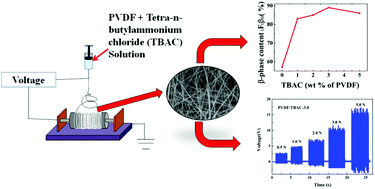Cationic surfactant assisted enhancement of dielectric and piezoelectric properties of PVDF nanofibers for energy harvesting application
Abstract
Poly(vinylidene fluoride) (PVDF) is among the most versatile polymers due to its wide range of properties, including dielectric, piezoelectric and ferroelectric properties. However, more frequently than not a range of processing routes and/or additives have been used to enhance such properties. In this study, PVDF nanofibers were electrospun from PVDF solution that contained tetra-n-butyl ammonium chloride (TBAC) at different loadings (1, 2, 3, and 5 wt%). The effect of TBAC on the morphology, crystallinity, and polymorphism of PVDF was studied using various characterization techniques. Addition of TBAC significantly improved the electroactive β-phase of PVDF. The highest β-phase content of 89% was attained at a TBAC loading of 3 wt%. Consequently, the dielectric and piezoelectric properties of the PVDF nanofibers improved significantly. A nanogenerator fabricated using 3 wt% TBAC/PVDF nanofibers exhibited the maximum voltage output of 17.2 V (under 5 N force) and the maximum power density of ∼1.4 μW cm−2 (under 3 N force). Improved dielectric and piezoelectric properties of PVDF upon the addition of a small amount of TBAC could be useful for researchers in upbringing the material for flexible electronic devices.



 Please wait while we load your content...
Please wait while we load your content...